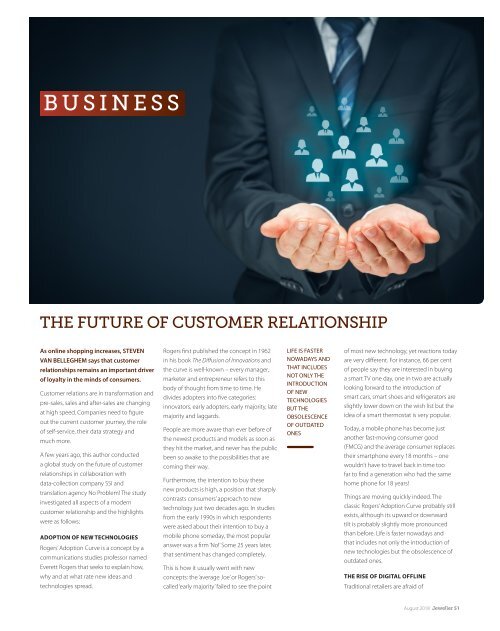You also want an ePaper? Increase the reach of your titles
YUMPU automatically turns print PDFs into web optimized ePapers that Google loves.
BUSINESS<br />
THE FUTURE OF CUSTOMER RELATIONSHIP<br />
As online shopping increases, STEVEN<br />
VAN BELLEGHEM says that customer<br />
relationships remains an important driver<br />
of loyalty in the minds of consumers.<br />
Customer relations are in transformation and<br />
pre-sales, sales and after-sales are changing<br />
at high speed. Companies need to figure<br />
out the current customer journey, the role<br />
of self-service, their data strategy and<br />
much more.<br />
A few years ago, this author conducted<br />
a global study on the future of customer<br />
relationships in collaboration with<br />
data-collection company SSI and<br />
translation agency No Problem! The study<br />
investigated all aspects of a modern<br />
customer relationship and the highlights<br />
were as follows:<br />
ADOPTION OF NEW TECHNOLOGIES<br />
Rogers’ Adoption Curve is a concept by a<br />
communications studies professor named<br />
Everett Rogers that seeks to explain how,<br />
why and at what rate new ideas and<br />
technologies spread.<br />
Rogers first published the concept in 1962<br />
in his book The Diffusion of Innovations and<br />
the curve is well-known – every manager,<br />
marketer and entrepreneur refers to this<br />
body of thought from time to time. He<br />
divides adopters into five categories:<br />
innovators, early adopters, early majority, late<br />
majority and laggards.<br />
People are more aware than ever before of<br />
the newest products and models as soon as<br />
they hit the market, and never has the public<br />
been so awake to the possibilities that are<br />
coming their way.<br />
Furthermore, the intention to buy these<br />
new products is high, a position that sharply<br />
contrasts consumers’ approach to new<br />
technology just two decades ago. In studies<br />
from the early 1990s in which respondents<br />
were asked about their intention to buy a<br />
mobile phone someday, the most popular<br />
answer was a firm ‘No!’ Some 25 years later,<br />
that sentiment has changed completely.<br />
This is how it usually went with new<br />
concepts: the ‘average Joe’ or Rogers’ socalled<br />
‘early majority’ failed to see the point<br />
LIFE IS FASTER<br />
NOWADAYS AND<br />
THAT INCLUDES<br />
NOT ONLY THE<br />
INTRODUCTION<br />
OF NEW<br />
TECHNOLOGIES<br />
BUT THE<br />
OBSOLESCENCE<br />
OF OUTDATED<br />
ONES<br />
of most new technology, yet reactions today<br />
are very different. For instance, 66 per cent<br />
of people say they are interested in buying<br />
a smart TV one day, one in two are actually<br />
looking forward to the introduction of<br />
smart cars, smart shoes and refrigerators are<br />
slightly lower down on the wish list but the<br />
idea of a smart thermostat is very popular.<br />
Today, a mobile phone has become just<br />
another fast-moving consumer good<br />
(FMCG) and the average consumer replaces<br />
their smartphone every 18 months – one<br />
wouldn’t have to travel back in time too<br />
far to find a generation who had the same<br />
home phone for 18 years!<br />
Things are moving quickly indeed. The<br />
classic Rogers’ Adoption Curve probably still<br />
exists, although its upward or downward<br />
tilt is probably slightly more pronounced<br />
than before. Life is faster nowadays and<br />
that includes not only the introduction of<br />
new technologies but the obsolescence of<br />
outdated ones.<br />
THE RISE OF DIGITAL OFFLINE<br />
Traditional retailers are afraid of<br />
<strong>August</strong> <strong>2018</strong> <strong>Jeweller</strong> 51


















